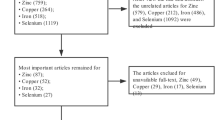Abstract
The effects of FeCl3 and Fe–EDTA on the development of psoriasis were studied in the mouse model of vaginal epithelium and tail epidermis. The mitoses of vaginal epithelial cell in female mice of their estrogenic stage and the formation of granular cell layers in male mouse tail scale were observed. Mice were randomly divided into eight groups and treated with normal saline, methotrexate, and different doses of two iron forms, FeCl3 and Fe–EDTA, respectively, for 10 days. To explore the influence of FeCl3 and Fe–EDTA on the excretion of Cu, Fe, Zn, Ca, Mg, Mn, and Se, the concentration of those elements in liver and kidney was analyzed by atomic absorption spectrometry. The different doses of FeCl3 or Fe–EDTA could obviously inhibit the mitoses of vaginal epithelial cell (p< 0.05) and promote the formation of granular cell layers in mice tail scale (p < 0.05). No statistically significant results were found between the groups of FeCl3 and Fe–EDTA, and between experimental groups and methotrexate group acted as the positive control (p>0.05). Compared with the negative group, the concentrations of Cu, Fe, Zn, Ca, Mg, Mn, and Se in liver and kidney of experimental groups and positive control group were not significantly changed (p > 0.05). FeCl3 and Fe–EDTA are as effective as methotrexate on inhibiting hyperplasia of epidermal cells and increasing the formation of granular cell layers, and the concentrations of Cu, Fe, Zn, Ca, Mg, Mn, and Se in liver and kidney of experimental groups and positive control group were not significantly changed compared with the negative group, possibly retarding the development of psoriasis.


Similar content being viewed by others
References
DiSepio D, Chandraratna RA, Nagpal S (1999) Novel approaches for the treatment of psoriasis. Drug Discov Today 4(5):222–231
Serwin AB, Wasowica W, Gromadzinska J, Chodynicka B (2003) Selenium status in psoriasis and its relations to the duration and severity of the disease. Nutrition 19(4):301–304
Julia T, Mamelak AJ, Sauder DN (2006) Current advancements in the treatment of psoriasis. Clin Appl Immunol Rev 6(5):465–483
O'Neill JL, Kalb RE (2009) Ustekinumab in the therapy of chronic plaque psoriasis. Biologics 3:159–168
Pastore S, Gubinelli E, Leoni L (2008) Biological drugs targeting the immune response in the therapy of psoriasis. Biologics 2(4):687–697
Ding ZY, Sun XJ (2003) Trace elements determination of psoriasis patients’ serum. J Clin Dermatol 32(9):525
Hu TZ, Zhang Y (1999) Five trace elements determination of psoriasis patients’ hair. Chinese journal of leprosy skin 19(1):40–41
Finzi AF (1994) Update on nutrition and psoriasis. Int J Dermatol 33(7):523
Keszthelyi B, Kiss AM, Tóth A (1976) Iron absorption and loss in psoriasis. Acta Med Acad Sci Hung 33(2):125–131
Zhang JH (2009) Effect of the combination of intravenous iron with reduced glutathione hormone supplementation on oxidative stress in hemodialysis patients. Anhui Med J 30(9):1062–1064
Bonder RH, Van Scott EJ (1971) Use of mouse vaginal and rectal epithelium to screen antimitotic effects of systemically administered drugs. Cancer Res 31(6):851–853
Jarrett A (1973) The physiology and pathophysiology of the skin. Lancet 2(7826):45
Zhao HT, Yao L, Wang J (2007) Research on security of iron-glycine and functional experiment. Food Res Dev 28(12):5–7
Patel RV, Clark LN, Lebwohl M, Weinberg JM (2009) Treatments for psoriasis and the risk of malignancy. J Am Acad Dermatol 60(6):1001–1017
Mendonca CO, Burden AD (2003) Current concepts in psoriasis and its treatment. Pharmacol Ther 99(2):133–147
Basavaraj KH, Darshan MS, Shanmugavelu P (2009) Study on the levels of trace elements in mild and severe psoriasis. Clin Chim Acta 405(1–2):66–70
Cao GH, Chen JL (1999) The impact of iron deficiency and supplementation on lipid peroxidation and superoxide dismutase enzyme. Chin Med 71(9):623
Cao JQ, Cui R (2005) Trace elements determination of psoriasis patients’ serum. China J Lepr Skin Dis 8(21):617–618
Ghosh A, Mukhopadhyay S, Kar M (2008) Role of free reactive iron in psoriasis. Indian J Dermatol Venereol Leprol 74(3):277–278
Leveque N, Robin S, Muret P (2004) In vivo assessment of iron and ascorbic acid in psoriatic dermis. Acta Derm Venereol 84(1):2–5
Sato S (1991) Iron deficiency: structural and microchemical changes in hair, nails, and skin. Semin Dermatol 10(4):313–319
Kurz K, Steiqleder GK, Bisebof W (1987) PIXE analysis in different stages of psoriatic skin. JInvest Dermatol 88(22):23–26
Mateus C, Franck N, Leclerc S (2007) Vulvar dermatitis and iron deficiency. Ann Dermatol Venereol 134(1):45–47
Satos S (1991) Iron deficiency: structural and microchemical changes in hair, nails, and skin. Semin Dermatol 10(4):313–319
Rosenthal NS, Farhi DC (1999) Bone marrow findings in connective tissue disease. Am J Clin Pathol 92(5):650–654
Zhang X, Guo DM, Lin XY, Cui X (2006) Analysis on absorption rate of iron and calcium in representive diets of children in rural area of Shandong province. Chinese Journal of Public Health 22(5):555–556
Author information
Authors and Affiliations
Corresponding author
Rights and permissions
About this article
Cite this article
Shi, Q., Yang, Xq. & Cui, X. The Effects of FeCl3 and Fe–EDTA on the Development of Psoriasis. Biol Trace Elem Res 140, 73–81 (2011). https://doi.org/10.1007/s12011-010-8671-8
Received:
Accepted:
Published:
Issue Date:
DOI: https://doi.org/10.1007/s12011-010-8671-8




